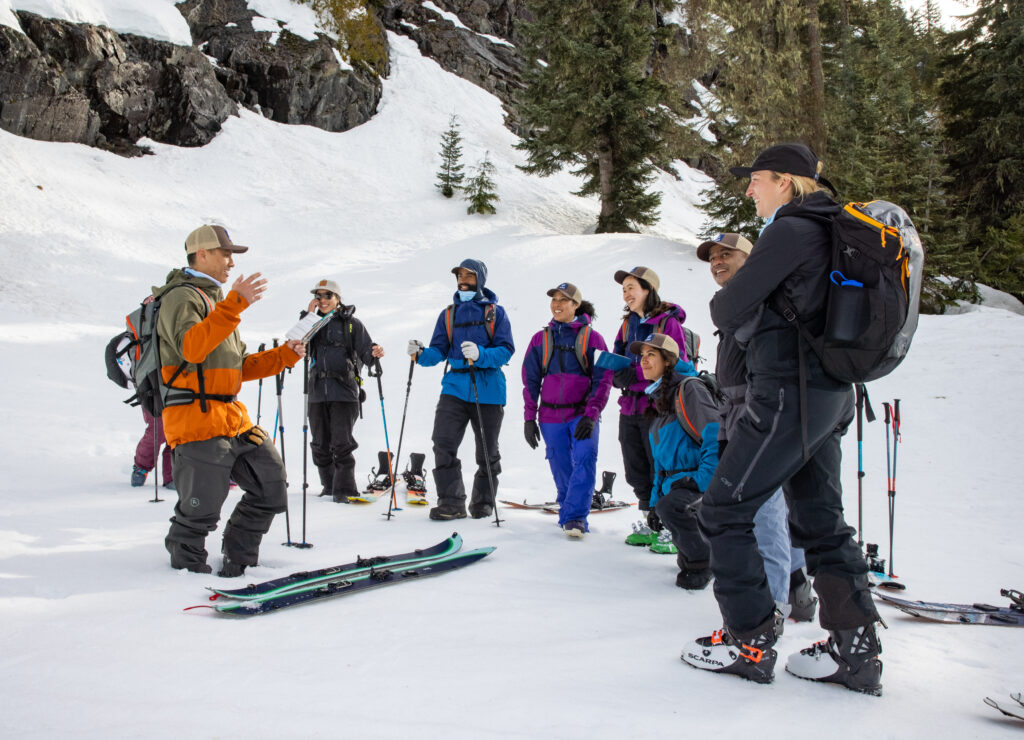What kind of training do I need to enter into backcountry terrain?

Congratulations for taking this step in your avalanche education! If you’ve had no previous formal training, Backcountry Basics can help you gain an awareness of the dangers that avalanches present and steps you can take to stay safe. Avalanche education can be a lifelong journey. This and similar avalanche awareness materials can be a great way to refresh your foundational knowledge. Avalanche awareness programs typically focus on a handful of basic topics like those mentioned in our introduction to avalanche safety. Awareness programs often require a short time-commitment, they’re accessible to a wide range of people, and are available at minimal expense. Other awareness resources are readily available online, in print, and through short, in-person classes or webinars including:
- NWACs Avalanche Awareness classes
- Know Before You Go videos and online content
- Avalanche Basics tutorial
While being aware of the dangers of avalanches is important, to safely travel in the backcountry you’ll need more in-depth and hands-on training. Formal avalanche training, like a Level 1 course, will give you the tools to safely make decisions in or around avalanche terrain. You’ll also practice what to do in the event of an avalanche. This course dives deeper into how to Get the Forecast, Get the Picture, and Get out of Harm’s Way along with other important topics. Level 1 courses are taught by qualified professional instructors and guides. They occur over multiple days and include on-snow, field components where students can practice newly learned skills. These skills include:
- Using an avalanche transceiver, probe, and shovel to rescue a companion caught in an avalanche
- Accessing a regional avalanche forecast to anticipate the days avalanche danger before going into the mountains
- Group management and communication
- Recognizing avalanche terrain
- Observing snow, weather, and avalanche clues that indicate dangerous avalanche conditions
- Using a decision-making process to choose terrain and manage your risk of getting caught in an avalanche
- Applying backcountry travel techniques to minimize exposure to avalanche terrain
Other in-person classes include Avalanche Rescue, Avalanche Level 2, and a suite of professional avalanche training. You can find more on the formal progression of avalanche courses from the American Avalanche Association as well as an informal progression on NWAC’s website. For consistency from one course to the next, avalanche course providers use a standard curriculum for each course. Most avalanche courses in the US use curriculum developed by either AIARE (American Institute for Avalanche Research and Education) or AAI (American Avalanche Institute). Check out offerings from avalanche course providers around the Northwest.

Your learning will continue well beyond each class. It’s important to revisit course materials and practice skills each season. Beyond a formal avalanche course, mentorship can help you apply new knowledge and skills. You can find mentorship from profesional guides and instructors or from experienced friends whom you trust. An ideal mentor will:
- Exhibit good judgement and have a track record of safe decision-making in avalanche terrain
- Be enthusiastic about mentoring and value learning
- Be a good communicator and active listener
- Allow you to practice skills while being comfortable with any risks involved
- Give you feedback of what you did well and what you can improve upon while being respectful of you and others
Whether you’re new to learning about avalanches or looking to refresh your knowledge, you’ve come to the right place. Backcountry Basics and the resources that we link to will get you started. If your goal is to travel in the backcountry, we recommend that you either hire a professional guide or sign up for a Level 1 avalanche course. Keep reading to learn how you can Get the Forecast, Get the Picture, and Get out of Harm’s Way.
More Classes
- Avalanche Awareness Class: This virtual class provides a basic approach to managing risk. NWAC instructors will explain how to access avalanche and mountain weather forecasts and recognize basic signs of avalanche danger.
- Laying Tracks Workshop Series: Learn the fundamentals around travel in the wintertime backcountry. Each Zoom Webinar will focus on a skill that helps you build a travel plan and understand your resources for traveling in avalanche terrain.
- AIARE Level 1 Course: Students can expect to develop a good grounding in how to prepare for and carry out a backcountry trip, to understand basic decision making while in the field, and to learn rescue techniques required to find and dig up a buried person (if an avalanche occurs and someone in the party is caught).
- AIARE Rescue Course: One-day stand alone course that is intended to be retaken on a regular basis in order to keep abreast of best practices in rescue techniques and gear.
- Member Webinars: A continuing education series for NWAC members that will help you get the most out of NWAC products & sharpen your backcountry tool set.
- Northwest Snow and Avalanche Workshops: An all day workshop designed to address the latest in snow and avalanche education.
- Find a Mentor & Build Experience: Join a club, hire a guide, ask more experienced friends to take you out! Experience traveling in the mountains is the key to internalizing all the above training.